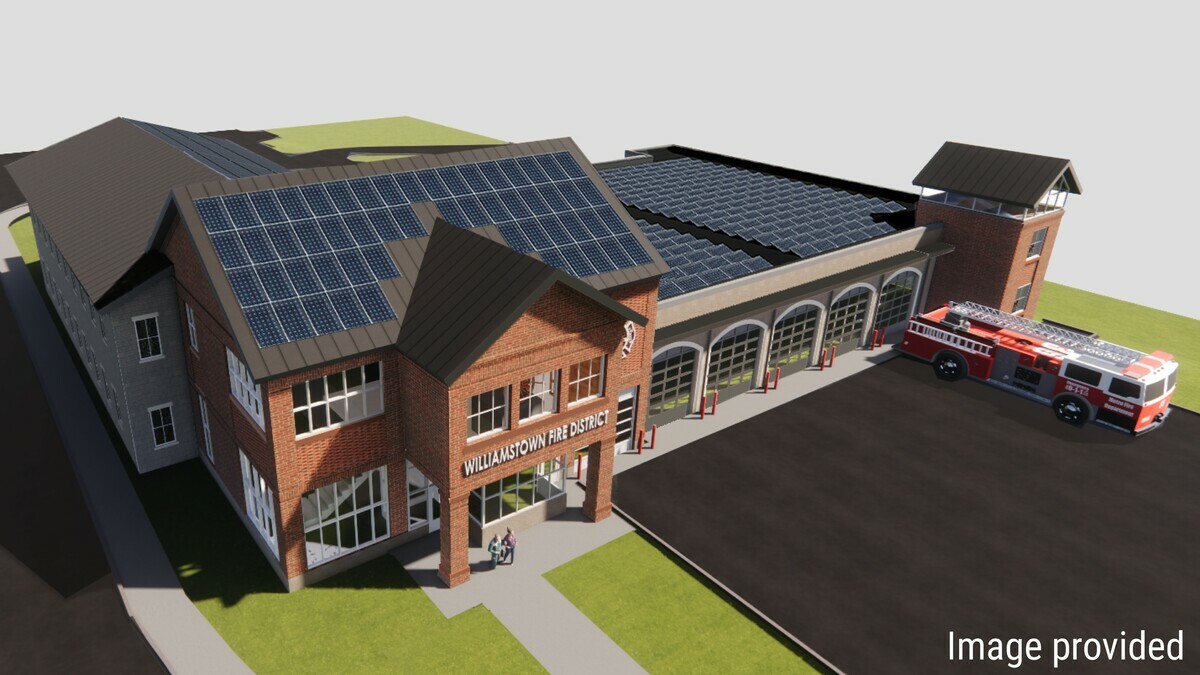Williamstown Fire District Outlines Green Elements of Proposed StationBy Stephen Dravis, iBerkshires Staff
12:00PM / Tuesday, November 29, 2022 | |
 An architect's rendering of the proposed new Williamstown Fire Station on Main Street (Route 2) shows the solar photovoltaic panels that are planned. An architect's rendering of the proposed new Williamstown Fire Station on Main Street (Route 2) shows the solar photovoltaic panels that are planned. |
WILLIAMSTOWN, Mass. — Fire District officials hope that residents in February will allow the district to build a new station that meets firefighters' needs and meets the town's goal of achieving net zero greenhouse gas emissions by 2050.
Earlier this month, the Williamstown Fire District held a public forum to discuss the ways that its building project aligns with the ambitious target that town meeting approved in 2021.
Chris Schaffer of sustainable design firm The Green Engineer of Concord and Chris Wante of Pittsfield architect EDM outlined some of the features that planners are incorporating in the design process in a presentation at the Williamstown Youth Center that was recorded by the town's community access television station, Willinet.
Wante explained that the project is being designed with an eye toward obtaining certification from the International Living Future Institute, a Seattle-based non-profit dedicated to fostering a society that is "socially just, culturally rich, and ecologically restorative."
"At the ILFI, their main goal is to not just build a building that is green or sustainable," Wante said. "They're talking about doing better, buildings that actually give back to the environment and are regenerative.
"That's one of the exciting things about this project. There are ways to track and certify the high goals that the project is searching for."
Wante said there are three major steps to achieving the third-party certification.
The first is to reduce the operational and embodied carbon in the new station. The second is to document and disclose how much energy the new building uses. The third is to offset any carbon usage through on-site energy production and the purchase of carbon offsets to make up for any embodied carbon that is used.
Embodied carbon, the emissions associated with building materials throughout a building's life cycle, is of particular concern for projects like the proposed fire station, Schaffer said.
"If a building becomes more efficient, embodied carbon is a bigger chunk of the building's footprint," Schaffer said. "We need to select materials that have a lower impact – recycled material, lower carbon concrete and steel."
To make the station more efficient, the designers are incorporating features like a high-efficiency heat pump, more insulation, LED lighting, high performance glazing on the windows and maximum use of solar panels on the site.
"Within the building, efficiency is important," Schaffer said. "We have a hierarchy of strategies. It starts with reducing demand – everything from using natural light to capturing a breeze on a nice day. Then we look at the systems and make them efficient."
One way to measure efficiency is through a building's energy use intensity, Schaffer said. A simple calculation of that EUI involves dividing energy used by square footage.
"If you look at a typical fire station of this size, it would have an EUI of 65 kilowatt BTUs per square foot per year," Schaffer said. "Our design is targeting 35 or below. That fits into some of the incentive programs as well, so we can get some funding from Mass Save to help us do that."
The designers said there were financial incentives available from the commonwealth for buildings that maximize efficiency. District officials also talk about the long-term payout of energy savings balancing the upfront cost of steps like buying solar panels.
Wante said the project is being decided to produce a little more electricity from solar photovoltaics than the station will need on day one in anticipation that energy needs will fluctuate in the future.
"Ultimately, the payback period [for panels] right now with direct purchase is under a decade," Wante said. "You pay for it in six years, and every year from six to 20, it's paying for itself."
The initial cost estimates to build a new station are "on the north side of $20 million," district officials say, but they are working to refine the initial cost estimate and, they hope, lower it before putting the bond question to residents at a special Fire District meeting on Feb. 28.
| 
